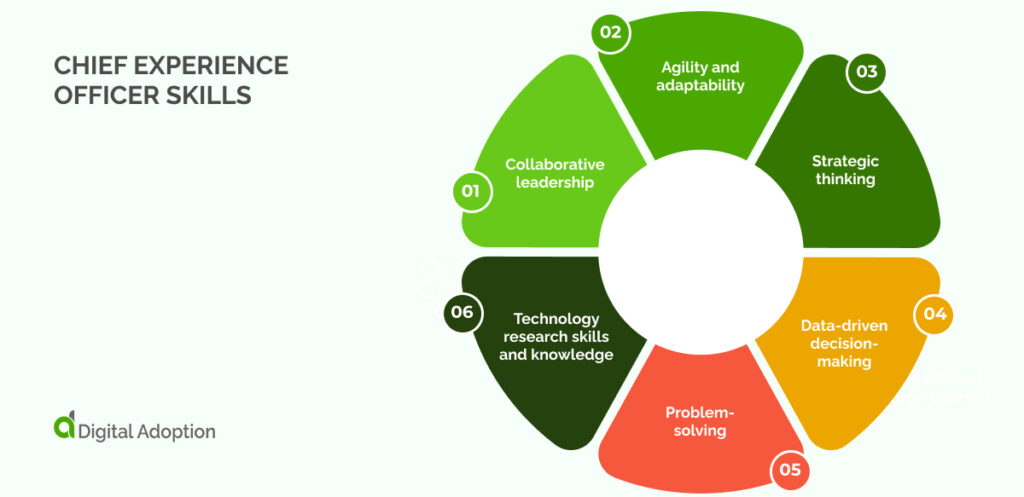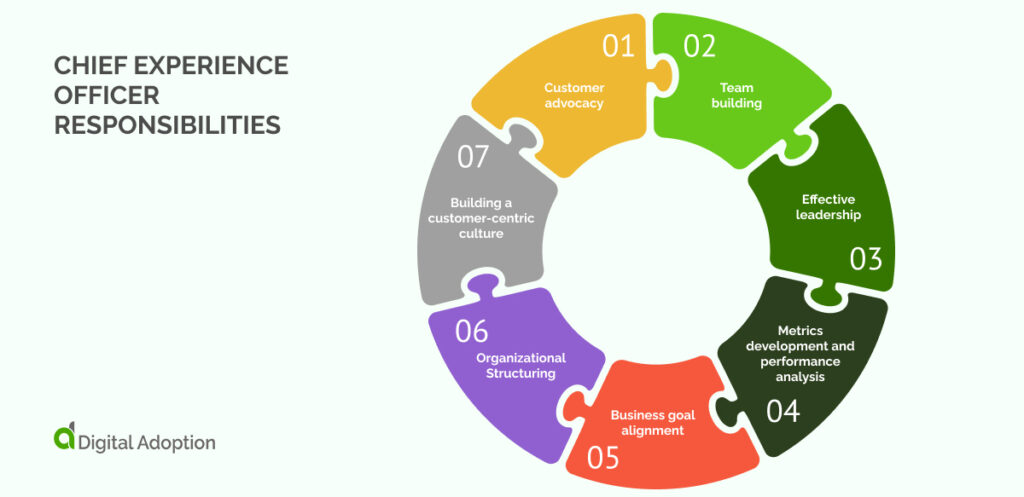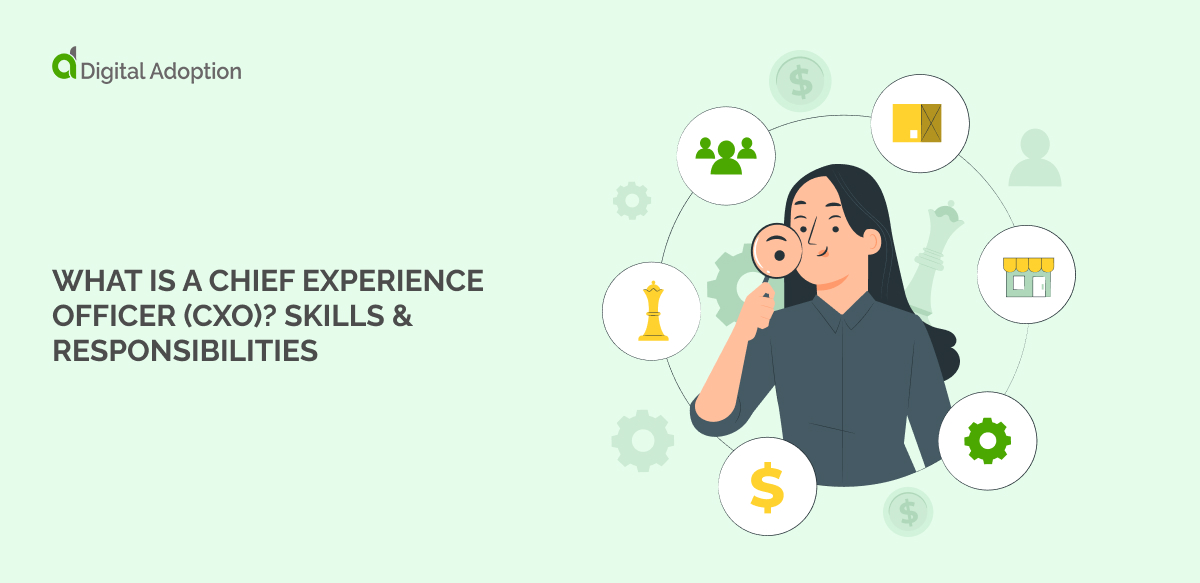A positive experience across an enterprise is challenging but essential to delivering the best digital business strategy and boosting digital adoption.
Your chief experience officer (CXO) oversees and ensures the best experience for customers and the employees who support them, increasing employee retention and reducing customer retention cost.
CXOs must keep their finger on the pulse of employee experience by advising other C-suites on what technologies to invest in to give team members the best workplace environment that makes them want to stay, increasing employee retention.
This article covers the definition of a CXO, what they do, skills, responsibilities, and qualities. Once you have read each section, you will know what a chief experience officer is and why they’re essential to your company.
What is a chief experience officer?
A Chief Experience Officer (CXO) enhances revenue and growth by strategically improving the company’s customer and employee experience programs.
Also known as the Chief Customer Officer (CCO) or Chief Customer Experience Officer (CCXO), CXOs hold a C-suite position. Their influence extends across the organization, as frontline employees engage with customers daily and monitor product experience data to develop products that make their organization thrive.
The CXO role is essential to any enterprise. It ensures customer satisfaction and employee retention, driving productivity and revenue.
What does a chief experience officer do?
To understand the role, you need to know what the CXO does. Their role falls into three main areas: customer experience, employee experience, and strategic growth. The first and most important is customer experience, as this is the end goal for the other two.
Enhancing customer experience
The CXO develops and implements strategies to improve customer interactions and satisfaction. This process involves analyzing customer feedback, identifying pain points, and designing solutions to enhance the customer journey.
Promoting a customer-centric culture ensures that every department aligns its efforts to meet customer needs, ultimately driving loyalty and retention.
Example initiatives may include personalized services, streamlined support processes, and innovative product offerings that exceed customer expectations.
Improving employee experience
The CXO creates a positive work environment by implementing professional development programs and recognition systems and promoting work-life balance.
Understanding and addressing employee needs ensures staff feel valued and engaged.
The benefits are clear: higher productivity, lower turnover, and better customer service, as satisfied employees contribute positively to the organization.
Driving strategic growth
The CXO aligns customer and employee experiences with strategic goals, collaborating with C-suite executives to integrate insights into business strategies. This holistic approach identifies market opportunities, optimizes efficiencies, and promotes innovation.
Motivated, creative employees enhance the organization through meaningful experiences. This strategic alignment ensures sustainable growth by enabling the company to adapt to evolving market demands and maintain a competitive edge.
Consider the above to see if you see gaps that a CXO could fill. Use this data to inform your hiring of a new CXO.
Chief experience officer skills

Unsurprisingly, the skills necessary to offer outstanding experience can be broad and specific. They range from broader C-suite skills like collaborative leadership to technology research skills and knowledge.
The difference between the CXO and other C-suites is the complexity of prioritizing employee needs to reach organizational goals. Other C-suites may be more focused on organizational goals than the needs of individual employees.
Collaborative leadership
Experience covers every aspect of the organization, and C-suites oversee every critical process to ensure it runs smoothly and reaches organizational objectives.
The CXO must be an expert collaborative leader who can influence each C-suite member and help them understand how their decisions can impact the experience for customers and employees.
They achieve this aim through many means, such as leading cross-functional teams, facilitating open communication, and encouraging diverse perspectives by hiring from various backgrounds. These actions help create unified customer and employee experience strategies.
Agility and adaptability
As technology, like the boom in generative AI applications, changes industries, it also changes customer expectations and impacts employees. This point means that experienced leaders must consider how new digital tools will result in adjustments to strategies to keep up and ensure competitive approaches stay sustainable.
They achieve this by quickly adjusting strategies in response to market changes and leveraging feedback to dynamically enhance customer and employee experiences according to changing needs.
Strategic thinking
Like any C-suite, CXOs must have excellent strategic thinking skills to help their initiatives be successful and align with organizational aims. Unlike other C-suites, this role requires that every strategy encompass employee and customer experience to ensure success, sales, and employee engagement.
The CXO identifies long-term goals, aligns initiatives with business objectives, and anticipates market trends to drive sustained growth and innovation.
Data-driven decision-making
Although experience is challenging to measure in numbers, this is the quickest way to collect customer and employee satisfaction data. Therefore, the experienced officer must understand both types of data: experience and numerical.
Employee satisfaction survey questions help them identify trends they can use to make data-driven decisions for employee improvements to increase productivity.
Using analytics, the CXO interprets customer and employee data to inform strategies, measure success, and make evidence-based improvements.
Problem-solving
Being in charge of the experiences of thousands of employees is complex, making problem-solving an essential skill for every person in this role.
Three of the main problems CXO’s face include:
- Competing priorities: Balancing immediate operational needs with long-term strategic goals is challenging.
- Cross-departmental collaboration: Coordinating efforts and promoting effective communication between various departments is difficult.
- Keeping updated on trends: Staying updated with rapidly changing market trends and technological advancements is time-consuming when digital change is the only constant.
The CXO addresses challenges by identifying root causes, developing creative solutions, and implementing effective strategies to enhance experiences.
Technology research skills and knowledge
Technology is part of everyone’s experience; the chief experience officer supports it daily. Therefore, the CXO must continuously update its knowledge to deliver the best experience.
Staying updated with the latest technology trends, the CXO evaluates and integrates tools that improve customer and employee interactions and operational efficiencies.
They liaise with other C-suites to share their knowledge on which technologies should not receive investment if they are likely to harm the experiences of staff and customers.
Does your current chief experience officer demonstrate all these skills daily? If the answer is no, they may need support from data analytics or social media teams to help them or require extra training.
Chief experience officer responsibilities

The experience of team members and customers drives enterprise success, making the chief experience officer’s responsibilities essential to maintaining organizational sustainability. The first of these responsibilities involves advocating for customer needs.
Customer advocacy
The CXO acts as the customer’s voice within the company, championing customer needs and preferences. The CXO implements feedback systems and champions customer-centric policies to enhance satisfaction and loyalty.
They implement feedback loops and advocate for customer-centric policies. Crucial outcomes include heightened customer satisfaction, loyalty, and improved product and service offerings.
Team building
The CXO builds a collaborative and motivated workforce by developing strong, customer-focused teams and investing in training, development, and recognition programs.
They develop training programs and recognition systems to build motivated, skilled teams focused on delivering exceptional customer experiences.
Essential outcomes are increased employee engagement, reduced turnover, and a more innovative and responsive team.
Effective leadership
The CXO leads by example, demonstrating a commitment to customer and employee experience. They inspire and guide the organization toward a unified vision.
Leading by example, the CXO inspires a customer-first mindset and guides the organization toward a unified vision of outstanding service.
Key outcomes are a strong, cohesive company culture, improved morale, and alignment across all levels of the organization.
Metrics development and performance analysis
Chief experience officers must actively listen to customers’ voices to enhance their understanding of them and drive future CX initiatives.
This responsibility involves utilizing feedback tools and solutions to gather insights directly from the target audience.
CXOs blend qualitative feedback with quantitative metrics and reports. They track NPS, CSAT, customer effort scores, and retention rates to identify opportunities for brand differentiation and competitive advantage.
Business goal alignment
The CXO ensures that customer and employee experience initiatives align with the company’s strategic objectives.
Integrating experience insights into business planning drives unified efforts towards common goals.
Critical outcomes include increased revenue, enhanced brand reputation, and sustained competitive advantage.
Organizational Structuring
The CXO designs and adjusts the organizational structure to support customer and employee experience priorities. This process involves creating cross-functional teams and defining roles, focusing on these experiences.
They create cross-functional teams dedicated to customer experience, ensuring the organizational structure supports seamless, customer-focused operations.
Key outcomes are improved efficiency, clearer accountability, and better execution of experience strategies.
Building a customer-centric culture
CXOs are often the catalyst for promoting a “customer-obsessed” company culture. They help business leaders and employees grasp the significance of customer experience initiatives. Some CXOs implement reward and recognition campaigns to promote customer-centric efforts.
By sharing best practices, reports, and insights across departments, CXOs ensure their teams consistently work towards enhancing the customer experience.
Review all the responsibilities above and consider whether your CXO fulfills them all. If they fall short with some of these responsibilities, liaise with them and ask if they need support.
Successful chief experience officer qualities
When hiring a CXO, look for four main qualities: ability to influence others, collaboration and partnership promotion, agility, and strategic thinking.
Influence skills
While CXOs only directly manage their function, they are responsible for transforming the entire business. Therefore, influencing, persuading, and guiding others is essential for effectiveness.
They must influence fellow C-suite members and the next level, energizing the organization with customer-led. Many CX leaders fall short here; it’s the most crucial skill and often a single point of failure.
Collaboration and partnership
CXOs must collaborate and build strong partnerships with other C-level leaders, including the CFO, CMO, COO, CHRO, and CEO. Understanding each leader’s objectives and business goals, the CXO uses these insights to gain their support for company-wide experience initiatives.
Agility
Successful CXOs apply agile practices to improve experiences within their organizations. This action involves quickly assembling cross-functional teams to execute and iterate on experience initiatives, effectively addressing customer and employee needs.
Strategic thinking
CXO innovators go beyond measuring KPIs like CSAT and NPS, aligning their efforts with the overall business strategy. Strategic thinking allows CXOs to connect customer and employee experience with key business outcomes, ensuring all C-suite members align with CX and EX initiatives.
Add these qualities to a checklist when interviewing chief officers to lead your experience strategy. They will help you ensure you hire the right CXO who is competent in their role.
CXOs must focus on aligning customer and employee experience
The key to success for any CXO is customer and employee experience alignment. But these are two need categories, so how do they create a unified response to both?
They must identify patterns in data by comparing customer and employee surveys. For example, they might notice similar pain points, feature requests, and high satisfaction with specific touchpoints.
They can use this data to satisfy the needs of both parties by working with C-suites to deliver technologies and experiences that meet the needs of everyone.
When the chief experience officer takes this approach, they use their skills to fulfill their responsibilities and deliver success and revenue to their organization.




![18 Examples of AI in Finance [2025]](https://www.digital-adoption.com/wp-content/uploads/2025/06/18-Examples-of-AI-in-Finance-2025-300x146.jpg)
![14 Examples of AI in Manufacturing [2025]](https://www.digital-adoption.com/wp-content/uploads/2025/06/14-Examples-of-AI-in-Manufacturing-2025-300x146.jpg)
![29 Examples of AI in Education [2025]](https://www.digital-adoption.com/wp-content/uploads/2025/06/29-Examples-of-AI-in-Education-2025-300x146.jpg)
![15 Examples of AI in Retail [2025]](https://www.digital-adoption.com/wp-content/uploads/2025/06/15-Examples-of-AI-in-Retail-2025-300x146.jpg)
![13 Examples of AI in Healthcare [2025]](https://www.digital-adoption.com/wp-content/uploads/2025/06/AI-in-healthcare-examples-300x146.jpg)


![18 Examples of AI in Finance [2025]](https://www.digital-adoption.com/wp-content/uploads/2025/06/18-Examples-of-AI-in-Finance-2025.jpg)
![14 Examples of AI in Manufacturing [2025]](https://www.digital-adoption.com/wp-content/uploads/2025/06/14-Examples-of-AI-in-Manufacturing-2025.jpg)
![29 Examples of AI in Education [2025]](https://www.digital-adoption.com/wp-content/uploads/2025/06/29-Examples-of-AI-in-Education-2025.jpg)